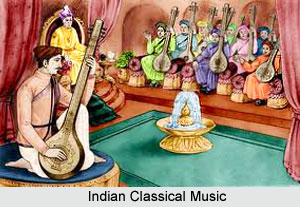 One of the most aesthetic aspects of Hindustani music, which either ignored or side-lined, is the raaga-raagini system. Medieval musicologists like Damodar Misra, author of Sangeet Darpana, Hanuman Matta and Someshwar Matta were responsible for popularizing this concept. This aspect is iconized in poetic form as dhyanamantram and in visual form as raagamalika paintings. A musician is supposed to mediate on this composite visual and verbal media and derive inspiration from them. Following this he proceeds to portray the raaga, line by line, contour by contour evoking both its outward form (rupa) and also its inbuilt attributes (guna). For instance, the early dawn Raaga Bhairav is depicted as follows:
One of the most aesthetic aspects of Hindustani music, which either ignored or side-lined, is the raaga-raagini system. Medieval musicologists like Damodar Misra, author of Sangeet Darpana, Hanuman Matta and Someshwar Matta were responsible for popularizing this concept. This aspect is iconized in poetic form as dhyanamantram and in visual form as raagamalika paintings. A musician is supposed to mediate on this composite visual and verbal media and derive inspiration from them. Following this he proceeds to portray the raaga, line by line, contour by contour evoking both its outward form (rupa) and also its inbuilt attributes (guna). For instance, the early dawn Raaga Bhairav is depicted as follows:
"Shiva seated as a sage atop Himalayas. Ganga falls on his matted locks. His head is adorned with the crescent moon. In the centre of his forehead - the third eye which reduced Kama to ashes. Serpents twine around his body and are smeared with ashes. He holds a trident in one hand and a skull in the other. He mounts Nandi which stands before him."
Raagas Megh and Malhar, associated with the monsoon season, are also depicted using evocative language and complemented with lovely miniature paintings, which often provide the guiding lines for raaga elaboration:
"Megh-Malhar is a good, wise king. He dances well and enjoys the pleasures of life with gay abandon. Of a slightly dusky complexion with bright shining eyes, King Megh-Malhar is dressed handsomely, wearing a tiger skin, and adorned with all kinds of bright ornaments. He is in the company of beautiful maidens bedecked with jewels. The king dances with them to the resounding beat of drums and clapping. The dancing and music bring forth clouds of various colours in the sky. The moving clouds thicken to the accompaniment of thunder and lightning which brings the rain."
Similarly raagas are also associated with emotions and feelings. In the raaga-raagini system, the masculine raagas embodied and portrayed feelings like wonder, courage and anger; while raaginis, or the feminine counterparts of the raagas, personified feelings like love, laughter and sorrow. In Sangeet Darpana, Damodar Misra maintains that there were six raagas, which were considered as masculine and 26 raaginis, which were feminine. The reasons for making such distinctions are not are not stated. The six masculine raagas comprise - Shree, Vasant, Bahirav, Panchama, Megh and Nat-Narayan. Each raaga affiliates with specific raaginis - usually six raaginis for one raaga. The raaga becomes a nayaka and the raagini the nayaki and their love-pranks were translated into miniature paintings by artists who belonged to the Rajasthan, Mughal, Kangra and Pahadi schools of painting. These paintings were reinforced by couplets, which describe the themes depicting the mood, the visualized figures and situations. A singer has to keep both the icon and the couplet in mind to help him evoke the mood of the raaga. For instance, the touch of mysterious sorrow inherent in the morning raaga Lalit is depicted in paintings, illustrating a woman waiting for her lover early in the morning and wondering with whom she should share the dream of her night (captured poignantly in the popular bandish, Raina ka sapna). Similarly, when artists sing the Malhar group of raagas, they evoke the dark clouds or snaking lightning seen in the raagamalika paintings and capture these musically, using words like dhoom and jhoom and make references to damini (lightning). The onomatopoeic references to the song of koels in spring-time raagas like Basant and Bahar, greatly punctuate the mood. Imaginative composers coalesce such visual and symbolic details into their bandishes; and sensitive singers endeavour to transmute these pictorial and poetic details into a melodic array. Strangely, some of the raagas depicted in the miniatures have vanished from the midst. Only the delightful pictorial depictions of these vanished melodies remain as mute testimonies of invigorating and colourful times.
North Indian classical music, as a system, came into being around the 14th and 15th centuries with the publication of important musical treatises like Raga Tarangini by Pandit Lochana and Raga Tatva Vibodha by Shrinivas Pandit. They wholly rejected the raaga-raagini system and put a more studied system into place. Pandit Lochana detailed the 12 thaats or the parent-scales for the classification of various raagas as also the 75 janya raagas, most of which are recognizable to this day. Shrinivas Pandit drew the fundamentals of raaga formation by relating their fundamental notes to melas or thaats. The notes to be included or excluded in raagas were rationalized using the logic of parent-scales to which they belonged. The foundation was thus set for the evolution of Hindustani music along ways and lines different from the past.




















